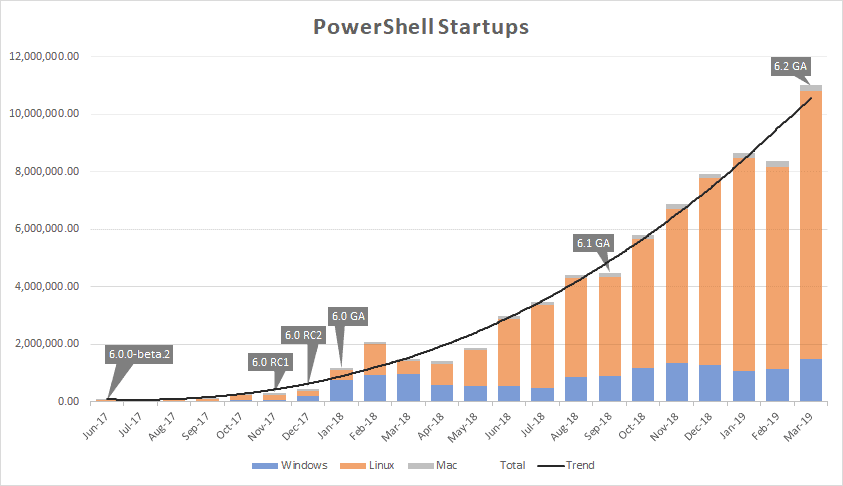PowerShell 7 announced: cross-platform, new lifecycle, Windows changes

Microsoft announced the next version of PowerShell Core this week. The next version will be PowerShell 7 and not PowerShell Core 6.3 as many expected. It signals a significant change in the development of PowerShell as Microsoft makes another important step in replacing the trusted PowerShell 5.1 on Windows with PowerShell Core.
Tip: Check out our PowerShell vs. PowerShell Core comparison to find out how the two differ from one another.
PowerShell Core usage increased significantly in the past two years especially on Linux platforms. Windows usage has stagnated on the other hand for the most part. Microsoft explains the lack of progress on the Windows platform with the existence of PowerShell 5.1 which offers functionality that PowerShell Core does not support.
Organizations and users on Windows rely on functions that PowerShell Core does not support, and that is the main reason why usage on Windows stagnates while it lifted off on Linux.
Microsoft devised a plan to change that, and PowerShell 7 is the key to the plan's success. PowerShell 7 is based on .NET Core 3.0 which means that compatibility with Windows PowerShell modules increases to over 90%.
PowerShell 7 will ship with Windows eventually; first, as a side-by-side feature with Windows PowerShell 5.1 so that users and administrators may use both versions of PowerShell on the same machine.
Microsoft expects the release to become available around May 2019. It depends on the general availability of .NET Core 3.0 and will be released shortly after the release of .NET Core 3.0.
Since PowerShell 7 is aligned with the .NET Core timeline, we expect the generally available (GA) release to be some time after the GA of .NET Core 3.0.
PowerShell 7 will move from a Microsoft Modern Lifecycle Policy to one that is more aligned with the .NET Core support lifecycle policy. One of the major improvements that comes out of the change is that PowerShell 7 will feature Long Term Service and non-Long Term Service releases.
Microsoft did not reveal how it plans to distribute PowerShell 7 on Windows. The most likely explanation is that it will be added as an optional feature first that needs to be installed separately to become available.
Plans to replace PowerShell 5.1 with future versions of PowerShell (Core) were not revealed but it seems likely that Microsoft will make a switch eventually to distribute PowerShell (Core) with Windows and make PowerShell 5.1 an optional component.
Now You: do you use PowerShell?






















“do you use PowerShell?”
Not often, but occasionally in conjunction with development on Windows at work. At home, I only run Linux — and PowerShell doesn’t offer me anything of value on Linux.
Powershell is really slow. CMD starts in less than 1 second and Bash loads in around 1 second, meanwhile Powershell will take 3-5 seconds. So I see no reason to use Powershell.
I’m lookin for an early 90’s IBM DOS ‘twin hard drive tower’ with multiple ram card slots,
to replace the one that someone absconded with a few years ago…I miss that machine as well
What is the purpose of having Powershell Core? It replicates Powershell isn’t it? It will be interesting to know how many people use Powershell instead of command line and who are not network admins etc. I am speaking of normal users who boot their PC to play a game or watch a movie. I have used Powershell maybe once last year (may be to run one command for disk cleanup) only because I found it fancy. I still trust command line.
So how many of you use Powershell? @MartinBrinkman do you?
I can’t see normal users ever using PowerShell knowingly, and I don’t think for a second that Microsoft is targeting those regular users with PowerShell.
As a sysadmin, I use PowerShell a lot for user onboardings/offboardings, managing Exchange/365 mailboxes, and even to tap into web service APIs.
The future is PowerShell Core and Microsoft is working on improving compatibility so that it can replace PowerShell on Windows eventually. Integration as a feature is the next step.
One of the few things about Windows, up to XP, that I actually liked, was that it was, essentially, DOS with a GUI. Now that DOS is merely emulated, it’s not so good. I used to pretty well live in a DOS environment and preferred it, in many ways. AmigaDOS was much more powerful, though. I really miss that machine. :(
@ K@: I remember back when i did fight with DOS on computers. It sure was a challenge, but i liked that challange.
I never came as far as Amiga, but i had both Commodre VIC-20 and 64. I still own five Commodore 64.
@stefann:
I’m old — I’ve been using computers from back when there were no commercial microcomputers at all. When I think back on the range that I’ve used, from the PDP/11 to today’s newest machines, the C64 still remains my favorite.
History:
https://en.wikipedia.org/wiki/MS-DOS#End_of_MS-DOS
If Commodore had had a decent publicity team, we’d be using Amigas, instead of this IBM-compatible rubbish. Way more powerful than Winderz, at the time. You could live, quite happily, with the GUI, or the CLI/DOS.
Pity.